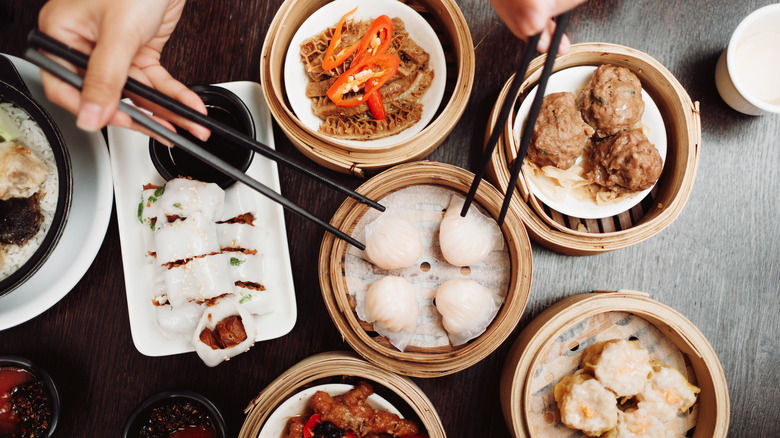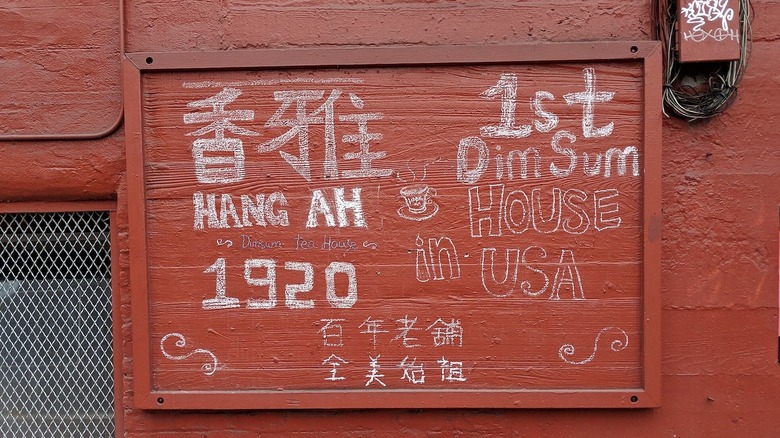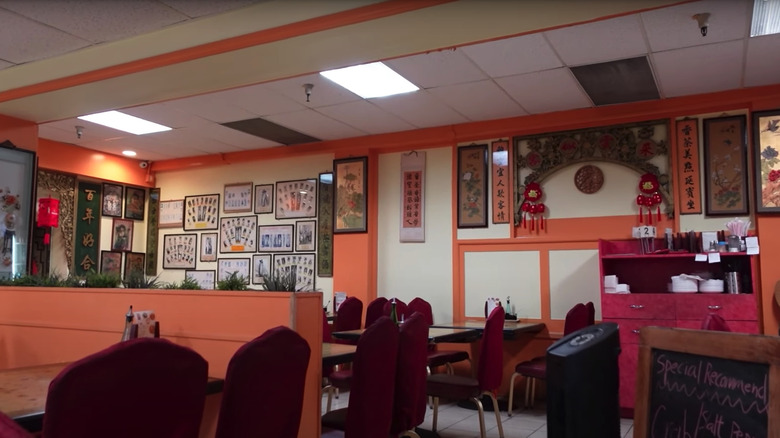San Francisco Is Home To America's Oldest Dim Sum Restaurant
It takes more than good luck for a restaurant to mark its 100th anniversary — and keep going. It takes dedicated owners, great food, and, usually, a prime location. San Francisco's Hang Ah Tea Room has two out of three going for it. Established in 1920, Hang Ah Tea Room occupies a nondescript storefront tucked down a pedestrian alley steps from Chinatown's Sacramento Street. It's in an unassuming location opposite the city's Willy "Woo-Woo" Wong Playground. Tourists in search of dim sum routinely seek out the spot because of its heritage. It's been widely covered in travel guides as the oldest dim sum restaurant in the United States (although New York City's Nom Wah Tea Parlor, also established in 1920, contends that claim).
That's all well and good, but the true mark of a good restaurant of any caliber — especially a historic landmark restaurant — is whether or not it has a local following. Hang Ah Tea Room checks that box, too. In early 2023, San Francisco lifestyle vlogger Rose Catherine shared highlights from a recent visit, asserting Hang Ah Tea Room serves "the most authentic dim sum I've ever had outside of China." The vlogger also gave a special shoutout to a few favorite selections including the Hang Ah purse dumpling, pan-fried turnip cake, fried stuffed tofu, and wonton with Hang Ah's special chili sauce. That's barely scratching the surface of the menu, but before we dive into dim sum, let's take a look back at where it all began.
A look back in time
When Hang Ah Tea Room opened in 1920, San Francisco was on the rebound from the destruction of the 1906 earthquake and fire that destroyed the city. A now-iconic symbol of the City by the Bay, the Golden Gate Bridge wasn't even on the drawing board, and early 20th-century gangster Al Capone hadn't yet stepped foot on Alcatraz. But someone whose name has been lost to history was about to open a hole-in-the-wall restaurant that has remained in operation at the same Chinatown location for more than 100 years — and through five changes in ownership. Current owners, Billy Lai and Frank Chui, bought the establishment in 2014, but only after assuring the sellers, who were getting ready to retire after 40-plus years of ownership, that they wouldn't change a thing. They have remained true to their word, even retaining the original name, a nod to an incense manufacturer that once occupied a nearby storefront. (Hang ah is a Cantonese reference to scent or aroma.)
In 2021, Chui told the San Francisco Chronicle that, by the time the previous owners were ready to sell, they were opening the restaurant at most three days a week. Hellbent on saving the iconic spot from obscurity, Chui and Lai gradually built the schedule back to seven days a week and grew the menu to include dozens of dim sum offerings including items made according to original recipes, seasonal specialties, and non-traditional takes on dim sum like egg custard dumplings and pumpkin mochi pancakes.
The legacy continues
Prior to purchasing Hang Ah Tea Room with Lai, Chui, who immigrated to San Francisco from Hong Kong in his teens, had little experience in the restaurant industry. That didn't deter him. When Lai, a college buddy, called to discuss the opportunity, Chui took a leap of faith and — during the process — learned about distant relatives who had owned the dim sum parlor in the 1950s. Kismet? Maybe. Chui and Lai's commitment to tradition was on point. There's a sense of familiarity that keeps regulars coming back. The exterior may be unremarkable, but the interior offers a sense of place. Red chairs line wood-topped tables sitting on a ceramic tile floor. The mellow orange trim gives the dining room a warm vibe. There's a kitschy collection of vintage memorabilia, photos of long-ago Miss Chinatown contestants, and Chinese calligraphy line the walls.
Sometimes returning patrons share memories. In 2021, Chui told the San Francisco Chronicle about a woman who grew up in Chinatown. She returns annually at New Year with her grandchildren. Then there's the man who arrives every year on his late father's birthday. One patron from the midwestern U.S. was on a quest to visit the restaurant where his parents had their first date. "Those are the stories that keep us going," Chui told SFGate. "They make us want to keep this living museum alive so folks can come in, think about the good old days, and also build new memories for generations to come."


